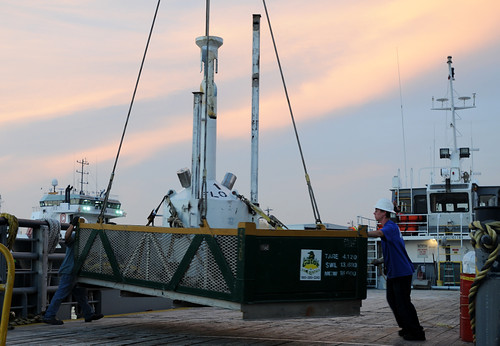Preface 1: BP will attempt to seal the leak using heavy drilling fluids and then cement:
BP likely will try to shut down the well completely late this week using a technique called “top kill,” BP Chief Operating Officer Doug Suttles said at a news conference Monday.The process involves pumping heavy drilling fluids through two 3-inch lines into the blowout preventer that sits on top of the Macondo wellhead a mile underwater. This would first restrict the flow of oil from the well, which then could be sealed permanently with cement.
If this works, it could stop the oil flow. I hope it works.
If it doesn't work, and if no one comes up with a better idea, the following proposal is a last-ditch fallback plan.
Preface 2: This proposal will only work if the seabed upon which the leaking oil equipment sits is made of rock. If the mud on the seabed is too thick, it won't work.
BP has never publicly released geological cross-sections of the seabed and underlying rock. BP's Initial Exploration Plan refers to "structure contour maps" and "geological cross sections", but such drawings are designated "proprietary information" and have been kept under wraps.

Here's a graphic from the Times-Picayune showing the same thing (and accurately showing that there are currently 3 leaking oil plumes): We need to drop something big, flat and very heavy that will cover the entire area where the leaks are occurring with such tremendous weight that it will act like a new layer of rock which seals all of the oil.
We need to drop something big, flat and very heavy that will cover the entire area where the leaks are occurring with such tremendous weight that it will act like a new layer of rock which seals all of the oil.
Like what?
A barge would be perfect.
Barges are large, heavy, flat-bottomed boats. They are designed to carry a lot of weight:
A typical barge measures 195 by 35 feet (59.4 m × 10.6 m), and can carry up to 1,500 tons of cargo.
That's a typical barge. Some can carry much more.
The military could sail or tow a huge barge to the spill site, and then sink it.
Using a number of vessels with the ability to guide the barge down to the spill site using cable (drill ships, ocean cable-laying ships, tow boats or whatever has the strongest cable winches), the barge is carefully lowered down to the spill site at a controlled speed.
Engineers lowered the 100-ton containment dome:
And the 2-ton top hat containment cap:
So one or several vessels could certainly lower a barge.
Nautical engineers will - obviously - make sure that the flat bottom stays flat-side down.
Once in the correct position, many more tons of iron, concrete, rock and/or heavy, obsolete machinery can be piled on top of the barge to add weight.
Water pressure 5,000 feet below the ocean surface is around 2,500 pounds per square inch.
The barge (with ballast) will be heavy enough to simply crush the blowout preventers, pipes and other drilling equipment as flat as a pancake (or you can remove some equipment first).
Then you pour concrete over the barge until it forms a sarcophagus. You seal the whole thing with concrete.
Concrete is poured underwater all the time. The pressure on the seafloor where the leak is occurring is obviously quite high. So this would be extreme conditions. But scientists and engineers could pipe down concrete and adjust for the pressure.
The barge with balast and concrete will then permanently form an impenetrable seal ... as strong or stronger than the rocks which BP drilled through in the first place.
Would it work?
Note 1: BP is drilling a second rig near the first, and will start pumping oil out in 3 months or so. So the barge only has to seal the spill for a couple of months.
Note 2: From all photographs and drawings I've seen, the ocean bed is flat at the oil spill site. If the sea floor is not perfectly flat, tiny metal pellets, sand or other small particles could be carefully dumped on the seabed before the barge touches bottom, to flatten out the area.
Note 3: This would cost a couple million dollars or perhaps up to a hundred million dollars, which is peanuts compared to the many hundreds of millions BP is already ineffectually spending, let alone the hundreds of billions or trillions in damage to the Gulf if this is not stopped immediately.
Note 4: I majored in environmental science at a good university.





